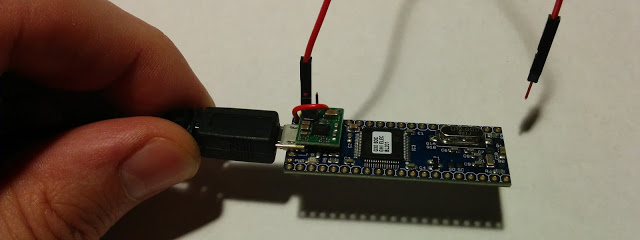Bringing up MicroPython on the GHI Electronics G30TH
I noticed that GHI Electronics makes a number of devices using the SM32F4 fmaily of processors, which also happens to be supported by MicroPython.
The G30TH caught my eye, which is basically a breakout board for the STM32F401RET6 which has 512K of flash and 96K of RAM.
Provide 3.3V
The board includes a USB connector, but doesn’t include any onboard regulator, so you’ll need to provide 3.3V to power the board.
I happened to have a Pololu 2842 in my drawer, so I decided to use that.
Being paranoid, I put a piece of kapton tape over the bottom of the regulator since it would be coming in contact with the metal housing on the USB connector. The Kapton tape makes the white silkscreen look yellow in the photo below:
While I still had access, I soldered a piece of wire to the VIN signal on the regulator, and then I soldered 2 header pins to the 3V3 and GND pins:
VOUT on the regulator connects to 3V3 on the G30TH, and GND on the regulator connects to GND on the G30TH. The red wire connects from VIN on the regulator to V+ on the G30TH. V+ on the G30TH connects to VUSB on the USB connector.
Now if you plug in the USB connector, both the PWR and USB LEDs should light.
Build the firmware
You can grab the micropython source code using git:
git clone https://github.com/micropython/micropython.git
and then install the G30TH board defintion into the tree:
cd micropython/stmhal/boards
git clone https://github.com/dhylands/G30TH.git
cd ..
Finally, build the firmware (from within the micropyton/stmhal directory):
make BOARD=G30TH
Get the Board into DFU mode
I used a wire jumper to connect from 3V3 and pressed it on the B0 (BOOT0). I used a female to female jumper wire with a single header pin plugged in one end:
I also used a short 6” USB cable to plug it into a USB extension cable. I found plugging the 6” cable into the extension to be quite a bit easier than plugging into the Micro B connector on the board. I could then hold the jumper on B0 with one hand and plug the USB cable into the extension with the other and get the board into DFU mode.
With the board in DFU mode, lsusb should show an entry like this:
Bus 001 Device 014: ID 0483:df11 STMicroelectronics STM Device in DFU Mode
and running dfu-util –list should report something like this:
$ dfu-util --list
dfu-util 0.8
Copyright 2005-2009 Weston Schmidt, Harald Welte and OpenMoko Inc.
Copyright 2010-2014 Tormod Volden and Stefan Schmidt
This program is Free Software and has ABSOLUTELY NO WARRANTY
Please report bugs to http://sourceforge.net/p/dfu-util/tickets/
Found DFU: [0483:df11] ver=2200, devnum=14, cfg=1, intf=0, alt=3, name="@Device Feature/0xFFFF0000/01*004 e", serial="377A364D3234"
Found DFU: [0483:df11] ver=2200, devnum=14, cfg=1, intf=0, alt=2, name="@OTP Memory /0x1FFF7800/01*512 e,01*016 e", serial="377A364D3234"
Found DFU: [0483:df11] ver=2200, devnum=14, cfg=1, intf=0, alt=1, name="@Option Bytes /0x1FFFC000/01*016 e", serial="377A364D3234"
Found DFU: [0483:df11] ver=2200, devnum=14, cfg=1, intf=0, alt=0, name="@Internal Flash /0x08000000/04*016Kg,01*064Kg,03*128Kg", serial="377A364D3234"
Unprotect the device
The firmware on the G30TH is protected, so the first thing that needs to be is to unprotect the device.
IMPORTANT: Once you unprotect the device (which will erase it) there’s no going back to the .NET firmware that came with it (since I don’t believe that firmware is distributed anywhere). So don’t expect to “try” MicroPython and go back to using .NET later.
The device can be unprotected using dfu-util:
dfu-util -s :unprotect:force -a 0 -d 0483:df11 -D build-G30TH/firmware.dfu
Note that DFU requires the -D option even though it won’t be using the firmware file. Unprotecting the device has the side effect of erasing it.
$ dfu-util -s :unprotect:force -a 0 -d 0483:df11 -D build-G30TH/firmware.dfu
dfu-util 0.8
Copyright 2005-2009 Weston Schmidt, Harald Welte and OpenMoko Inc.
Copyright 2010-2014 Tormod Volden and Stefan Schmidt
This program is Free Software and has ABSOLUTELY NO WARRANTY
Please report bugs to http://sourceforge.net/p/dfu-util/tickets/
Deducing device DFU version from functional descriptor length
Opening DFU capable USB device...
ID 0483:df11
Run-time device DFU version 011a
Claiming USB DFU Interface...
Setting Alternate Setting #0 ...
Determining device status: state = dfuERROR, status = 10
dfuERROR, clearing status
Determining device status: state = dfuIDLE, status = 0
dfuIDLE, continuing
DFU mode device DFU version 011a
Device returned transfer size 2048
DfuSe interface name: "Internal Flash "
Device disconnects, erases flash and resets now
Unprotecting the device also resets the device, so you’ll need to put it back into DFU mode once more.
Flash MicroPython
Now that the device is back in DFU mode once again, we can flash MicroPython:
make BOARD=G30TH deploy
If you’ve never flashed MicroPython before, there may be additional steps required. The wiki page for programming the STM32F4 Discovery Board should have the information required.
Once MicroPython has been programmed, then you can use your favorite terminal program to open /dev/ttyACM0 and get a REPL: (I often use usb-ser- mon.py)
$ usb-ser-mon.py
Waiting for USB Serial Device ...
USB Serial device with vendor 'MicroPython' serial '377A364D3234' connected @/dev/ttyACM0
Use Control-X to exit.
MicroPython v1.8.2-13-g08eac74 on 2016-07-14; G30TH with STM32F401CE
Type "help()" for more information.
>>>






